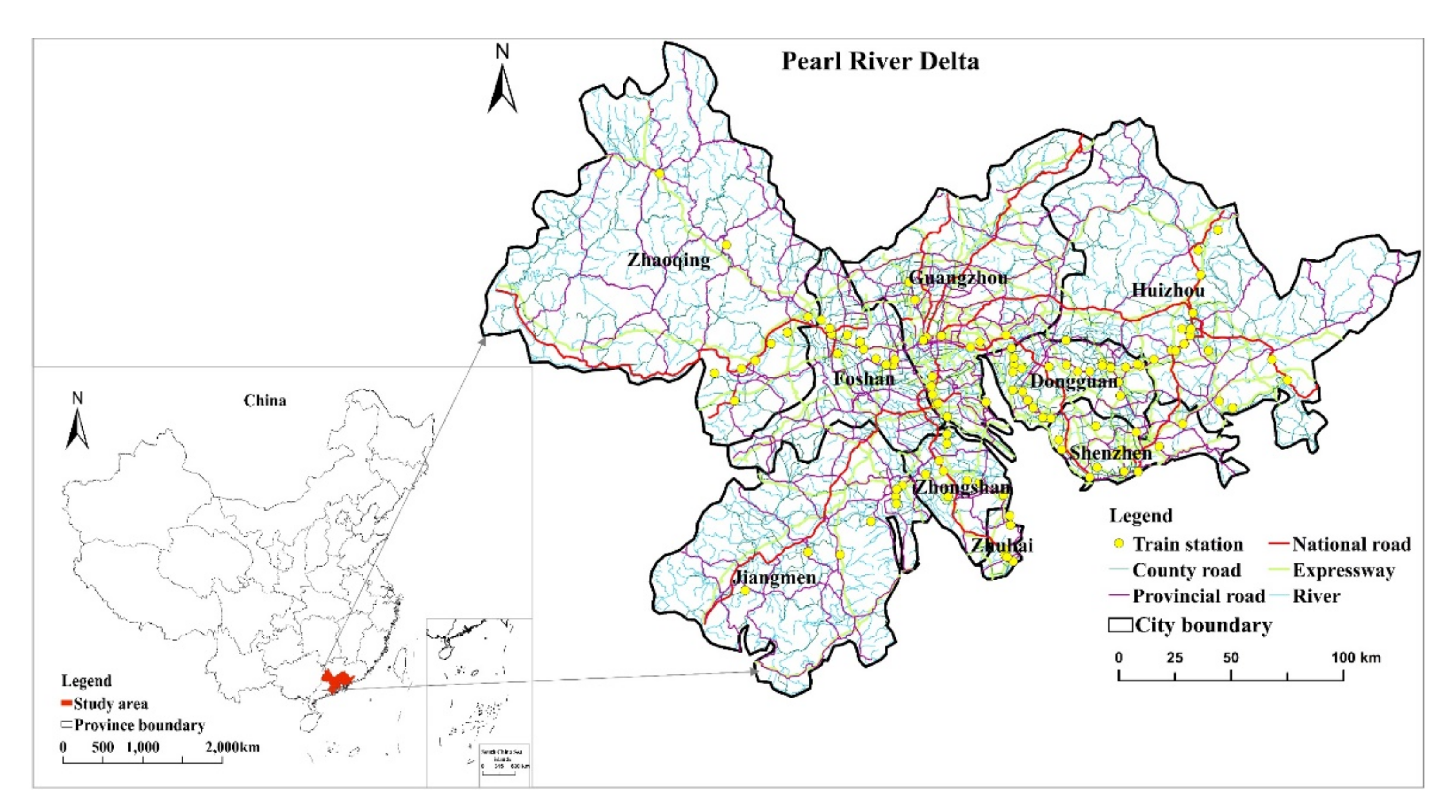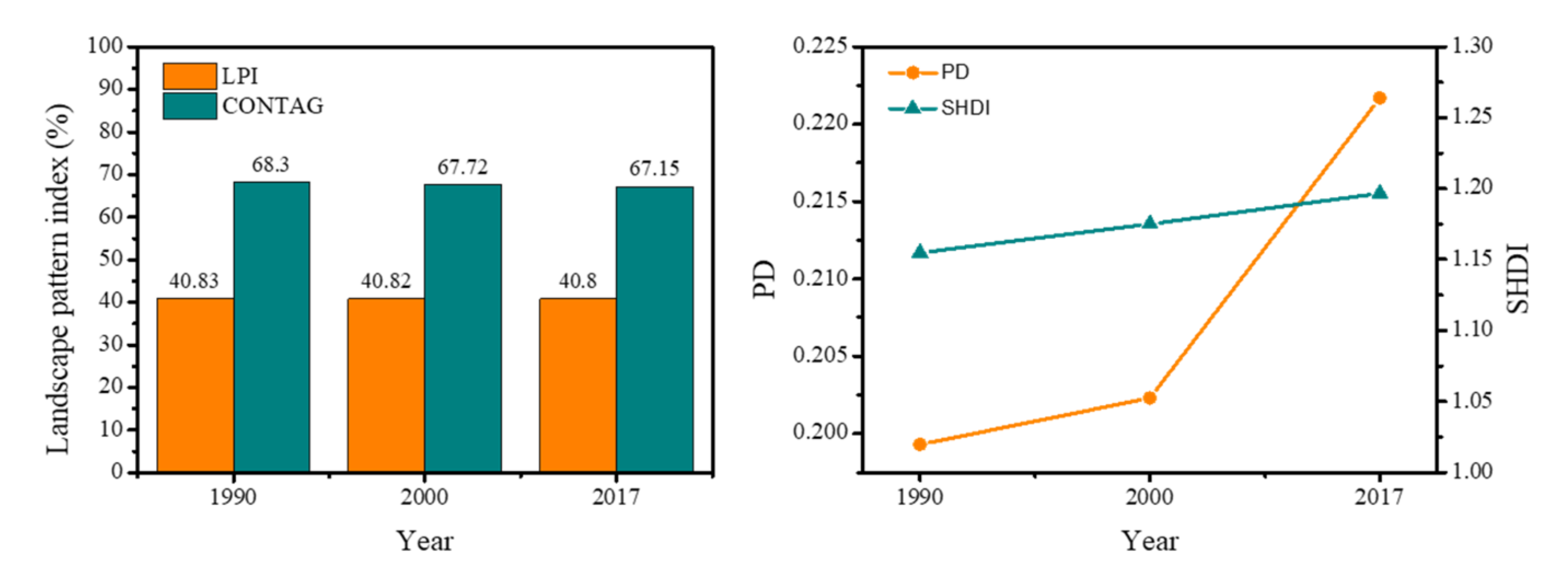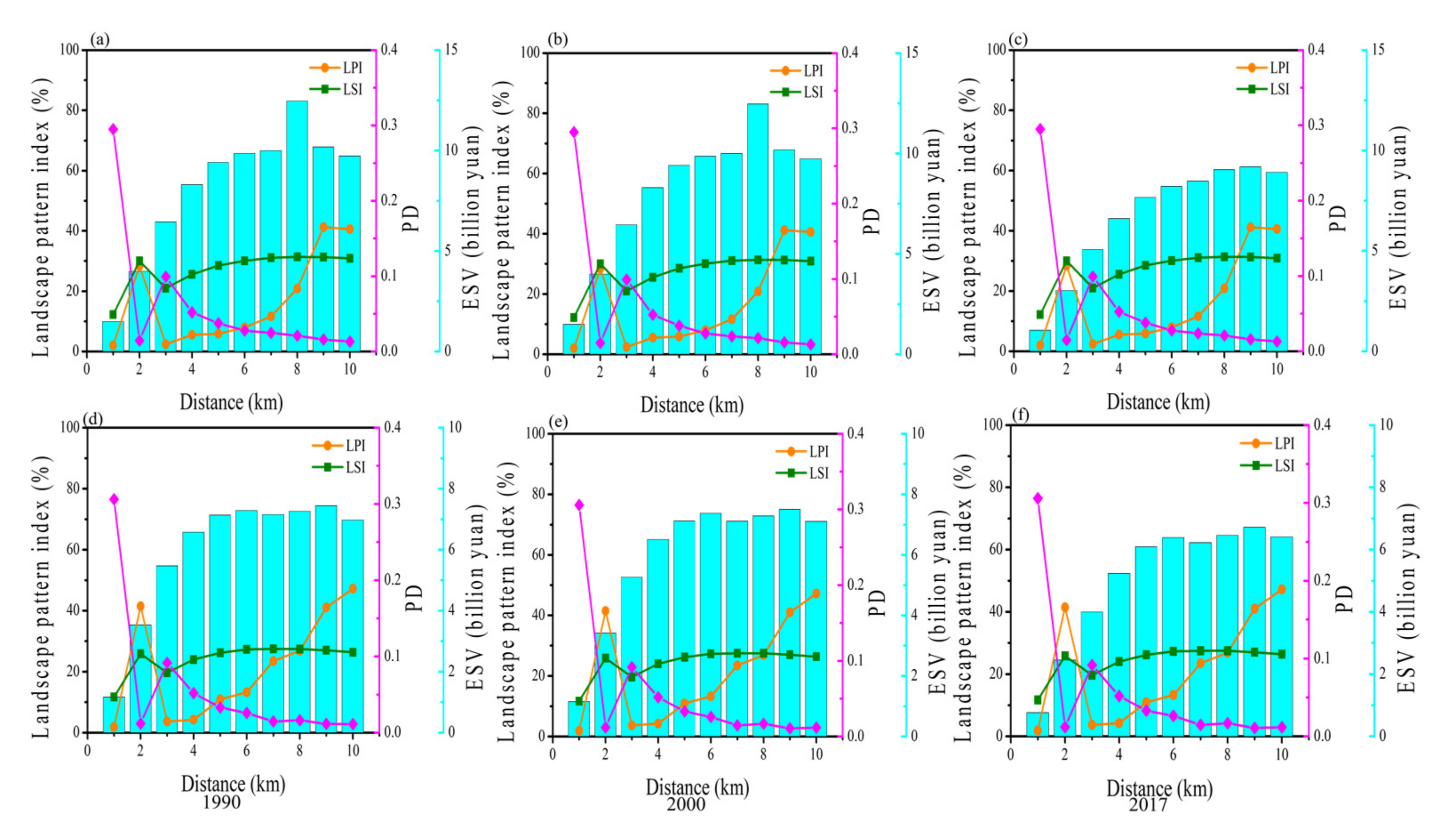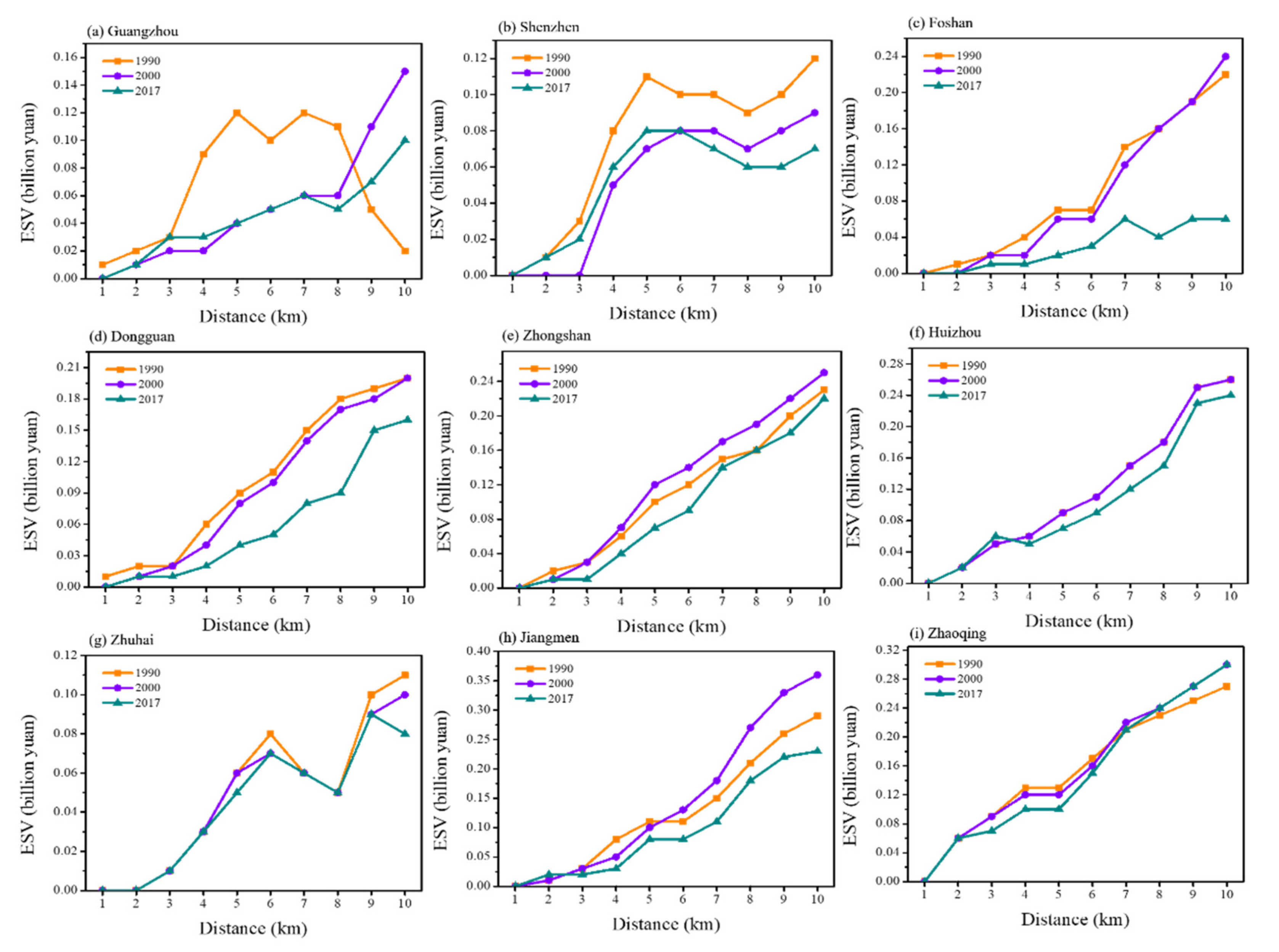Assessment of the Impact of Land Use Change on Spatial Differentiation of Landscape and Ecosystem Service Values in the Case of Study the Pearl River Delta in China
Abstract
:1. Introduction
2. Materials and Methods
2.1. Study Area
2.2. Data Sources
2.3. Methods
2.3.1. Buffer Analysis Method
2.3.2. Landscape Index Analysis
2.3.3. ESV Estimation
| Woodland | Grassland | Cropland | Waterbody | Unused Land | |
|---|---|---|---|---|---|
| Food | 697.39 | 908.72 | 2113.31 | 760.79 | 42.27 |
| Raw material | 6297.67 | 760.79 | 824.19 | 507.20 | 84.53 |
| Gas regulation | 9129.51 | 3169.97 | 1521.59 | 5093.08 | 126.80 |
| Climate regulation | 8601.18 | 3296.77 | 2049.91 | 28,635.39 | 274.73 |
| Water supply | 8643.45 | 3212.24 | 1627.25 | 28,402.93 | 147.93 |
| Waste treatment | 3634.90 | 2789.57 | 2937.51 | 30,431.71 | 549.46 |
| Soil formation and retention | 8495.52 | 4733.82 | 3106.57 | 4205.49 | 359.26 |
| Biodiversity protection | 9531.04 | 3951.90 | 2155.58 | 7798.12 | 845.33 |
| Recreation and culture | 4395.69 | 1838.58 | 359.26 | 9911.44 | 507.20 |
| Total | 59,426.36 | 24,662.36 | 16,695.17 | 115,746.15 | 2937.51 |
3. Results
3.1. The Spatial Distribution of Landscape Pattern and ESVs in the PRD Region
3.1.1. Spatial Distribution and Quantitative Changes in Land Use
3.1.2. Changes in Landscape Index and ESVs
3.2. Spatial Distribution and Changes of Landscape Pattern and ESVs
3.2.1. Landscape Index and ESVs Spatial Change Based on Road Buffer Zone
3.2.2. Spatial Change Based on Expressway Entrance and Exit and Train Station Buffer Zone
3.2.3. Landscape Index and ESVs Spatial Change Based on River Buffer Zones
3.2.4. ESVs Spatial Change Based on City Buffer Zone
4. Discussion
4.1. Urbanization and Industrialization Changed the Land Use Landscape Pattern and ESVs
4.2. The Scale of Urban Space Significantly Affects ESVs
4.3. The Siphon Effect of Traffic Stations Affects the Landscape and Ecology
4.4. Differences in Highway Grades and Development Activities around Rivers Affect Regional Landscape Ecology
4.5. Uncertainty
5. Conclusions
Author Contributions
Funding
Data Availability Statement
Conflicts of Interest
References
- Chen, L.D.; Sun, R.H.; Liu, H.L. Eco-environmental effects of urban landscape pattern changes: Progresses, problems, and perspectives. Acta Ecol. Sin. 2013, 33, 1042–1050. (In Chinese) [Google Scholar] [CrossRef] [Green Version]
- Fu, B.J.; Zhang, L.W. Land use change and ecosystem services: Concepts, methods and progress. Prog. Geog. 2014, 33, 441–446. (In Chinese) [Google Scholar]
- Meng, L.T.; Sun, Y.; Zhao, S.Q. Comparing the spatial and temporal dynamics of urban expansion in Guangzhou and Shenzhen from 1975 to 2015: A case study of pioneer cities in China’s rapid urbanization. Land Use Policy 2020, 97, 104753. [Google Scholar] [CrossRef]
- Li, F.; Ye, Y.P.; Song, B.W.; Wang, R.S. Evaluation of urban suitable ecological land based on the minimum cumulative resistance model: A case study from Changzhou, China. Ecol. Model. 2015, 318, 194–203. [Google Scholar] [CrossRef]
- Ning, J.; Liu, J.Y.; Kuang, W.H.; Xu, X.L.; Zhang, S.W.; Yan, C.Z.; Li, R.D.; Wu, S.X.; Hu, Y.F.; Du, G.M.; et al. Spatiotemporal patterns and characteristics of land-use change in China during 2010–2015. J. Geogr. Sci. 2018, 28, 547–562. [Google Scholar] [CrossRef] [Green Version]
- Forman, R.T.T.; Godron, M. Patches and structural components for a landscape ecology. Bioscience 1981, 31, 733–740. [Google Scholar]
- Daily, G.C. Nature’s services: Societal dependence on natural ecosystems. Pac. Conserv. Biol. 1997, 6, 220–221. [Google Scholar]
- Millennium Ecosystem Assessment. Ecosystems and Human Well-Being: Synthesis; Island Press: Washington DC, WA, USA, 2005. [Google Scholar]
- Kambo, A.; Drogemuller, R.; Yarlagadda, P. Assessing Biophilic Design Elements for ecosystem service attributes: A sub-tropical Australian case. Ecosyst. Serv. 2019, 39, 100977. [Google Scholar] [CrossRef]
- Graça, M.; Queirós, C.; Farinha-Marques, P.; Cunha, M. Street trees as cultural elements in the city: Understanding how perception affects ecosystem services management in Porto, Portugal. Urban For. Urban Green 2018, 30, 194–205. [Google Scholar] [CrossRef]
- Costanza, R.; d’Arge, R.; de Groot, R.S.; Farber, S.; Grasso, M.; Hannon, B.; Limburg, K.; Naeem, S.; O’Neill, R.V.; Paruelo, J.; et al. The value of the world’s ecosystem services and natural capital. Nature 1997, 387, 253–260. [Google Scholar] [CrossRef]
- Breyne, J.; Marc, D.; Kevin, M. How Integrating ‘Socio-Cultural Values’ into Ecosystem Services Evaluations can Give Meaning to Value Indicators. Ecosyst. Serv. 2021, 49, 101278. [Google Scholar] [CrossRef]
- Arias-Arévalo, P.; Gómez-Baggethun, E.; Martín-López, B.; Pérez-Rincón, M. Widening the Evaluative Space for Ecosystem Services: A Taxonomy of Plural Values and Valuation Methods. Environ. Values 2018, 27, 29–53. [Google Scholar] [CrossRef]
- Zhang, X.; He, S.; Yang, Y. Evaluation of wetland ecosystem services value of the yellow river delta. Environ. Monit. Assess. 2021, 193, 353. [Google Scholar] [CrossRef]
- Xie, G.D.; Lu, C.X.; Leng, Y.F.; Zheng, D.; Li, S.C. Ecological assets valuation of the Tibetan Plateau. J. Nat. Resour. 2003, 18, 189–196. (In Chinese) [Google Scholar]
- Das, M.; Das, A. Dynamics of Urbanization and its impact on Urban Ecosystem Services (UESs): A study of a medium size town of West Bengal, Eastern India. J. Urban Manag. 2019, 8, 420–434. [Google Scholar] [CrossRef]
- Hou, L.; Wu, F.Q.; Xie, X.L. The spatial characteristics and relationships between landscape pattern and ecosystem service value along an urban-rural gradient in Xi’an city, China. Ecol. Indic. 2020, 108, 105720. [Google Scholar] [CrossRef]
- Koellner, T.; de Baan, L.; Beck, T.; Brandão, M.; Civit, B.; Margni, M.; I Canals, L.M.; Saad, R.; de Souza, D.M.; Müller-Wenk, R. UNEP-SETAC guideline on global land use impact assessment on biodiversity and ecosystem services in LCA. Int. J. Life Cycle Assess. 2013, 18, 1188–1202. [Google Scholar] [CrossRef] [Green Version]
- Kremer, P.; Hamstead, Z.A.; Mcphearson, T. The value of urban ecosystem services in New York City: A spatially explicit multicriteria analysis of landscape scale valuation scenarios. Environ. Sci. Policy 2016, 62, 57–68. [Google Scholar] [CrossRef]
- Ye, Y.Q.; Bryan, B.A.; Zhang, J.E.; Connor, J.D.; Chen, L.L.; Qin, Z.; He, M.Q. Changes in land-use and ecosystem services in the Guangzhou-Foshan Metropolitan Area, China from 1990 to 2010: Implications for sustainability under rapid urbanization. Ecol. Indic. 2018, 93, 930–941. [Google Scholar] [CrossRef]
- Ruiz, J.; Domon, G. Analysis of landscape pattern change trajectories within areas of intensive agricultural use: Case study in a watershed of southern Québec, Canada. Landsc. Ecol. 2009, 24, 419–432. [Google Scholar] [CrossRef]
- Solomon, N.; Segnon, A.C.; Birhane, E. Ecosystem Service Values Changes in Response to Land-Use/Land-Cover Dynamics in Dry Afromontane Forest in Northern Ethiopia. Int. J. Environ. Res. Public Health 2019, 16, 4653. [Google Scholar] [CrossRef] [Green Version]
- Colléony, A.; Geisler, G.; Shwartz, A. Exploring biodiversity and users of campsites in desert nature reserves to balance between social values and ecological impacts. Sci. Total Environ. 2021, 770, 145255. [Google Scholar] [CrossRef] [PubMed]
- Asher, S.; Garg, T.; Novosad, P. The Ecological Impact of Transportation Infrastructure. Econ. J. 2020, 130, 1173–1199. [Google Scholar] [CrossRef]
- Stammel, B.; Fischer, C.; Cyffka, B.; Albert, C.; Damm, C.; Dehnhardt, A.; Fischer, H.; Foeckler, F.; Gerstner, L.; Hoffmann, T.G.; et al. Assessing land use and flood management impacts on ecosystem services in a river landscape (Upper Danube, Germany). River Res. Appl. 2021, 37, 209–220. [Google Scholar] [CrossRef]
- Phillips, B.B.; Bullock, J.M.; Osborne, J.L.; Gaston, K.J.; Manning, P. Ecosystem service provision by road verges. J. Appl. Ecol. 2020, 7, 488–501. [Google Scholar] [CrossRef]
- Bennett, V.J. Effects of Road Density and Pattern on the Conservation of Species and Biodiversity. Curr. Landsc. Ecol. Rep. 2017, 2, 1–11. [Google Scholar] [CrossRef]
- Haas, J.; Ban, Y.F. Urban growth and environmental impacts in Jing-Jin-Ji, the Yangtze, River Delta and the Pearl River Delta. Int. J. Appl. Earth Obs. 2014, 30, 42–55. [Google Scholar] [CrossRef]
- Ding, J.; Wang, K.Y. Spatio-temporal evolution of industrial production space and its driving mechanisms in Pearl River Delta urban agglomeration. Geogr. Res. 2018, 37, 53–66. (In Chinese) [Google Scholar]
- Liu, W.; Zhan, J.Y.; Zhao, F.; Yan, H.M.; Zhang, F.; Wei, X.Q. Impacts of urbanization-induced land-use changes on ecosystem services: A case study of the Pearl River Delta Metropolitan Region, China. Ecol. Indic. 2019, 98, 228–238. [Google Scholar] [CrossRef]
- Jiao, M.Y.; Hu, M.M.; Xia, B.C. Spatiotemporal dynamic simulation of land-use and landscape-pattern in the Pearl River Delta, China. Sustain. Cities Soc. 2019, 49, 101581. [Google Scholar] [CrossRef]
- Xu, Q.; Yang, R.; Zhuang, D.C.; Lu, Z.L. Spatial gradient differences of ecosystem services supply and demand in the Pearl River Delta region. J. Clean. Prod. 2021, 279, 123849. [Google Scholar] [CrossRef]
- Yang, R.; Zhang, J.; Xu, Q.; Luo, X.L. Urban-rural spatial transformation process and influences from the perspective of land use: A case study of the Pearl River Delta Region. Habitat Int. 2020, 104, 102234. [Google Scholar] [CrossRef]
- Eliezer, F.; Maciel, Z.; Jacob, S. Dictionaries of deep features for land-use scene classification of very high spatial resolution images. Pattern Recognit. 2019, 89, 32–44. [Google Scholar]
- Cui, S.; Su, H.; Ye, L.S.; Li, J.W. A Buffer Analysis Algorithm Based on Spatial Object. Geogr. Geo-Inf. Sci. 2011, 27, 38–41. [Google Scholar]
- Peng, J.; Wang, Y.L.; Zhang, Y.; Wu, J.S.; Li, W.F.; Li, Y. Evaluating the effectiveness of landscape metrics in quantifying spatial patterns. Ecol. Indic. 2010, 10, 217–223. [Google Scholar] [CrossRef]
- Su, S.; Ma, X.; Xiao, R. Agricultural landscape pattern changes in response to urbanization at eco-regional scale. Ecol. Indic. 2014, 40, 10–18. [Google Scholar] [CrossRef]
- Uuemaa, E.; Mander, Ü.; Marja, R. Trends in the use of landscape spatial metrics as landscape indicators: A review. Ecol. Indic. 2013, 28, 100–106. [Google Scholar] [CrossRef]
- Polasky, S.; Nelson, E.; Pennington, D.; Johnson, K.A. The Impact of Land-Use Change on Ecosystem Services, Biodiversity and Returns to Landowners: A Case Study in the State of Minnesota. Environ. Resour. Econ. 2011, 48, 219–242. [Google Scholar] [CrossRef]
- Nijhum, F.; Westbrook, C.; Noble, B.; Belcher, K.; Lloyd-Smith, P. Evaluation of alternative land-use scenarios using an ecosystem services-based strategic environmental assessment approach. Land Use Policy 2021, 108, 105540. [Google Scholar] [CrossRef]
- Yang, C. The transformation of foreign investment-induced ‘exo(genous)-urbanisation’ amidst industrial restructuring in the Pearl River Delta, China. Urban Stud. 2020, 57, 618–635. [Google Scholar] [CrossRef]
- Liu, T.; Liu, H.; Qi, Y.J. Construction land expansion and cultivated land protection in urbanizing China: Insights from national land surveys, 1996–2006. Habitat Int. 2015, 46, 13–22. [Google Scholar] [CrossRef]
- Yang, C.; Fu, T. From exports to sell in China: Transformation of the export-oriented furniture firms in the Pearl River Delta. Geogr. Ann. Ser. B-Hum. Geogr. 2017, 99, 380–398. [Google Scholar] [CrossRef]
- Zhu, C.M.; Zhang, X.L.; Zhou, M.M.; He, S.; Gan, M.Y.; Yang, L.X.; Wang, K. Impacts of urbanization and landscape pattern on habitat quality using OLS and GWR models in Hangzhou, China. Ecol. Indic. 2020, 117, 106654. [Google Scholar] [CrossRef]
- Qu, Y.; Long, H. The economic and environmental effects of land use transitions under rapid urbanization and the implications for land use management. Habitat Int. 2018, 82, 113–121. [Google Scholar] [CrossRef]
- Lonell, H.D.; Kinga, I. The assessment of the impact induced by the increase of impervious areas on surface runoff. Case study the city of Cluj-napoca, Romania. Carpath. J. Earth Environ. Sci. 2016, 11, 331–337. [Google Scholar]
- Shi, Y.S.; Shi, D.H.; Zhou, L.L.; Fang, R.B. Identification of ecosystem services supply and demand areas and simulation of ecosystem service flows in shanghai. Ecol. Indic. 2020, 115, 106418. [Google Scholar] [CrossRef]
- He, Y.T.; Wang, S.Y.; Yuan, Z.J.; Zheng, M.G.; Huang, B.; Liang, C. Land Use Change and Its Response to Urbanization in the Pearl River Delta. Ecol. Environ. Sci. 2020, 29, 303–310. [Google Scholar]
- Homosombat, W.; Ng, A.K.Y.; Fu, X. Regional transformation and port cluster competition: The case of the Pearl River Delta in South China: Regional transformation and port cluster competition. Growth Chang. 2016, 47, 349–362. [Google Scholar] [CrossRef]
- Faggio, G.; Silva, O.; Strange, W.C. Heterogeneous agglomeration. Rev. Econ. Stat. 2016, 99, 80–94. [Google Scholar] [CrossRef] [Green Version]
- Skorobogatova, O.; Kuzmina-Merlino, I. Transport Infrastructure Development Performance. Proced. Eng. 2017, 178, 319–329. [Google Scholar] [CrossRef]
- Pereira, P.; Gimeìnez-Morera, A.; Novara, A.; Keesstra, S.; Jordán, A.; Masto, R.E.; Brevik, E.; Azorin-Molina, C.; Cerdà, A. The impact of road and railway embankments on runoff and soil erosion in eastern Spain. Hydrol. Earth Syst. Sci. Discuss. 2015, 12, 12947–12985. [Google Scholar]
- Xu, Z.; Sun, T. The siphon effects of transportation infrastructure on internal migration: Evidence from China’s HSR network. Appl. Econ. Lett. 2020, 28, 179613. [Google Scholar] [CrossRef]
- Wu, C.F.; Lin, Y.P.; Chiang, L.C.; Huang, T. Assessing highway’s impacts on landscape patterns and ecosystem services: A case study in Puli Township, Taiwan. Landsc. Urban Plan. 2014, 128, 60–71. [Google Scholar] [CrossRef]
- Zhou, T.; Luo, X.; Hou, Y.; Xiang, Y.; Peng, S. Quantifying the effects of road width on roadside vegetation and soil conditions in forests. Landsc. Ecol. 2020, 35, 69–81. [Google Scholar] [CrossRef] [Green Version]
- Fidino, M.; Gallo, T.; Lehrer, E.W.; Murray, M.H.; Kay, C.A.M.; Sander, H.A.; MacDougall, B.; Salsbury, C.M.; Ryan, T.J.; Angstmann, J.L.; et al. Landscape-scale differences among cities alter common species’ responses to urbanization. Ecol. Appl. 2021, 31, e02253. [Google Scholar] [CrossRef]
- Su, J.; Yin, H.; Kong, F. Ecological networks in response to climate change and the human footprint in the Yangtze River Delta urban agglomeration, China. Landsc. Ecol. 2021, 36, 2095–2112. [Google Scholar] [CrossRef]








| Land-Use Type in 2000 | Land-Use Type in 1990 | ||||||
|---|---|---|---|---|---|---|---|
| Built-Up Land | Cropland | Grassland | Unused Land | Waterbody | Woodland | Total | |
| Built-up land | 2876.43 | 774.08 | 34.56 | 0.00 | 100.38 | 261.38 | 4046.82 |
| Cropland | 2.92 | 13,458.88 | 0.83 | 0.00 | 49.96 | 40.92 | 13,553.51 |
| Grassland | 0.00 | 0.00 | 1030.14 | 0.00 | 0.00 | 9.72 | 1039.86 |
| Unused land | 0.00 | 0.00 | 0.00 | 16.23 | 0.00 | 0.00 | 16.23 |
| Waterbody | 0.00 | 659.28 | 0.37 | 0.00 | 3162.27 | 5.04 | 3826.95 |
| Woodland | 0.48 | 32.84 | 21.24 | 0.00 | 3.21 | 29,588.15 | 29,645.92 |
| Total | 2879.82 | 14,925.07 | 1087.13 | 16.23 | 3315.82 | 29,905.20 | 52,129.28 |
| Land-Use Type in 2017 | Land-Use Type in 2000 | ||||||
|---|---|---|---|---|---|---|---|
| Built-Up Land | Cropland | Grassland | Unused Land | Waterbody | Woodland | Total | |
| Built-up land | 3815.02 | 2067.12 | 77.52 | 5.35 | 598.36 | 923.53 | 7486.89 |
| Cropland | 91.64 | 10,758.52 | 7.02 | 2.27 | 536.34 | 89.19 | 11,484.98 |
| Grassland | 1.66 | 4.11 | 888.22 | 0.01 | 4.34 | 176.23 | 1074.57 |
| Unused land | 0.05 | 0.10 | 0.00 | 5.62 | 0.22 | 0.33 | 6.32 |
| Waterbody | 54.83 | 406.44 | 9.73 | 1.99 | 2656.70 | 49.94 | 3179.63 |
| Woodland | 87.33 | 317.10 | 57.35 | 0.99 | 23.82 | 28,406.25 | 28,892.84 |
| Total | 4050.53 | 13,553.39 | 1039.85 | 16.23 | 3819.78 | 29,645.46 | 52,125.23 |
| Land-Use Type in 2017 | Land-Use Type in 1990 | ||||||
|---|---|---|---|---|---|---|---|
| Built-Up Land | Cropland | Grassland | Unused Land | Waterbody | Woodland | Total | |
| Built-up land | 2699.81 | 2911.90 | 109.88 | 5.35 | 590.50 | 1165.66 | 7483.10 |
| Cropland | 74.30 | 10,825.15 | 8.38 | 2.27 | 464.54 | 110.33 | 11,484.98 |
| Grassland | 1.48 | 4.09 | 881.32 | 0.01 | 4.48 | 183.20 | 1074.57 |
| Unused land | 0.05 | 0.12 | 0.00 | 5.62 | 0.20 | 0.33 | 6.32 |
| Waterbody | 44.55 | 837.79 | 10.25 | 1.99 | 2227.93 | 57.11 | 3179.63 |
| Woodland | 59.46 | 345.90 | 77.29 | 0.99 | 20.99 | 28,388.10 | 28,892.74 |
| Total | 2879.64 | 14,924.96 | 1087.12 | 16.23 | 3308.64 | 29,904.74 | 52,121.34 |
| Ecosystem Service Value (Billion Yuan) | Variation (Billion Yuan) | Rate of Change (%) | |||||||
|---|---|---|---|---|---|---|---|---|---|
| Land use type | 1990 | 2000 | 2017 | 1990–2000 | 2000–2017 | 1990–2017 | 1990–2000 | 2000–2017 | 1990–2017 |
| Cropland | 26.62 | 24.18 | 20.24 | −2.44 | −3.94 | −6.38 | −9.16 | −16.29 | −23.96 |
| Woodland | 392.79 | 390.31 | 286.62 | −2.47 | −103.70 | −106.17 | −0.63 | −26.57 | −27.03 |
| Grassland | 2.83 | 2.71 | 2.76 | −0.12 | 0.06 | −0.06 | −4.28 | 2.13 | −2.25 |
| Waterbody | 46.34 | 52.20 | 43.11 | 5.86 | −9.09 | −3.23 | 12.64 | −17.41 | −6.97 |
| Unused land | 0.01 | 0.01 | 0.00 | 0.00 | 0.00 | 0.00 | 0.00 | −70.85 | −70.85 |
| Total | 468.58 | 469.41 | 352.74 | 0.83 | −116.67 | −115.85 | 0.18 | −24.85 | −24.72 |
Publisher’s Note: MDPI stays neutral with regard to jurisdictional claims in published maps and institutional affiliations. |
© 2021 by the authors. Licensee MDPI, Basel, Switzerland. This article is an open access article distributed under the terms and conditions of the Creative Commons Attribution (CC BY) license (https://creativecommons.org/licenses/by/4.0/).
Share and Cite
Yang, R.; Qin, B.; Lin, Y. Assessment of the Impact of Land Use Change on Spatial Differentiation of Landscape and Ecosystem Service Values in the Case of Study the Pearl River Delta in China. Land 2021, 10, 1219. https://doi.org/10.3390/land10111219
Yang R, Qin B, Lin Y. Assessment of the Impact of Land Use Change on Spatial Differentiation of Landscape and Ecosystem Service Values in the Case of Study the Pearl River Delta in China. Land. 2021; 10(11):1219. https://doi.org/10.3390/land10111219
Chicago/Turabian StyleYang, Ren, Baoqing Qin, and Yuancheng Lin. 2021. "Assessment of the Impact of Land Use Change on Spatial Differentiation of Landscape and Ecosystem Service Values in the Case of Study the Pearl River Delta in China" Land 10, no. 11: 1219. https://doi.org/10.3390/land10111219
APA StyleYang, R., Qin, B., & Lin, Y. (2021). Assessment of the Impact of Land Use Change on Spatial Differentiation of Landscape and Ecosystem Service Values in the Case of Study the Pearl River Delta in China. Land, 10(11), 1219. https://doi.org/10.3390/land10111219





